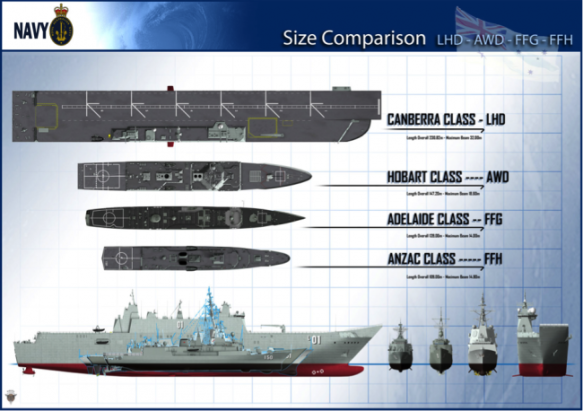SAM GOLDSMITH analyses three possible options for a better surface combatant mix for the RAN. In considerable technical detail, this forensic examination is essential reading for naval personnel and anyone concerned with getting the best force for Australia’s future. The full paper is here.
As a very large continental-scale island, Australia’s maritime credentials should be obvious. Australia has 25,760 km of coastline and 58,920 km2 of sea area under its jurisdiction. It is relatively isolated, but is flanked to the north by the Indonesian archipelago. Its geostrategic location, with strong ties to the Asian markets, and important military links with the USA and South East Asia make Australia vitally important. “As a significant medium power in the Asia-Pacific region, Australia inescapably is a participant in the most politically, economically, and strategically dynamic part of the world. …
As a maritime trading state highly dependent upon secure sea lanes of communication stretching from the Middle East to North America, Australia is tied comprehensively and profitably to Asia’s economic success.” As Commander Simon Bateman RAN points out: “Australia is a medium power on a world scale [and] Australia is also a medium maritime power.” It is interesting to note that Australia defines ‘medium power’ following Hill[1]; such is Hill’s influence on RAN thinking. Australia has contributed to both wars against Iraq and also the war in Afghanistan as well as taking unilateral action in its own backyard when it intervened in East Timor. Australian forces have also been at the forefront of disaster relief operations such as in Aceh and other areas affected by the 2004 tsunami. Australia’s security concerns are diverse, yet it places its focus on the maritime element.
It is significant that the title of the 2009 White Paper was Defending Australia in the Asia-Pacific Century. The Australian government bases its decisions on ‘strategic interests’ which are “those that endure irrespective of specific passing threats that may complicate our outlook from time to time.”
There is also a desire for operational autonomy whereby Australia must have the means to “act independently where we have unique strategic interests at stake, and in relation to which we would not wish to be reliant on the combat forces of any foreign power.”
Despite the wide type of security threats that Australia faces, “taking into account the strategic drivers, regional geography, and Prime Minister Rudd’s stated emphasis in 2008 on naval power, it should come as no surprise that by far the most significant force-structure initiatives in the white paper relate to maritime capability.” Under the subheading ‘Enhancing Our Maritime Forces’ the 2009 Defence White Paper explains, “The major new direction that has emerged through our consideration of current and future requirements is a significant focus on enhancing our maritime capabilities.
By the mid-2030s, we will have a heavier and more potent maritime force. The government will double the size of the submarine force (12 more capable boats to replace the current fleet of six Collins class submarines), replace the current Anzac class frigate with a more capable Future Frigate optimised for ASW; and enhance our capability for offshore maritime warfare, border protection and mine countermeasures.” Overall, Australia’s maritime focus “point toward the RAN’s being a well-balanced but vastly more capable and flexible regional naval force in the future.” The maritime theme was reaffirmed in the 2013 Defence White Paper.
[1] REAR ADMIRAL J. R. HILL
Royal Navy Officer 1942–1983. Editor of the Naval Review, 1983–2002 and reviews editor from 2002. He has been a member of Council, Greenwich Forum, 1983—date. He is extensively published with 14 books and numerous articles on maritime subjects including: Rear Admiral J. R. Hill, Maritime Strategy for Medium Powers, (Beckenham, Croom Helm, 1986); and as ‘Marlowe’,(1976) ‘The Medium Maritime Power-I’, Naval Review , Vol. 64, No. 2, 106–112; and (1976) ‘The Medium Maritime Power-II’, Naval Review , Vol. 64, No. 3, 213–221; and (1976) ‘The Medium Maritime Power-III’, Naval Review , Vol. 64, No. 4, 321–328; and (1977) ‘The Medium Maritime Power-IV’, Naval Review , Vol. 65, No. 1, 36–45; and Rear Admiral R. Hill, (1981) ‘Apocalypse When?’ RUSI Journal, 126: 2, 63–65; and (1984) ‘Maritime Forces for Medium Powers’, Naval Forces , Vol. 5, Issue 2, 26–32; and (2000) Medium Power Strategy Revisited, (Royal Australian Navy, Sea Power Centre).
